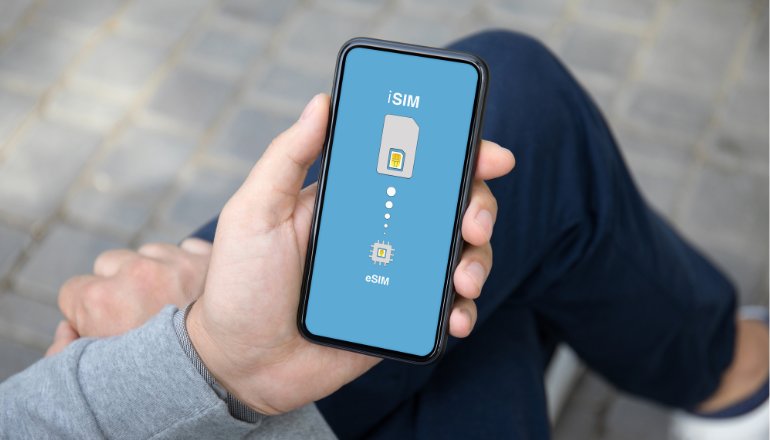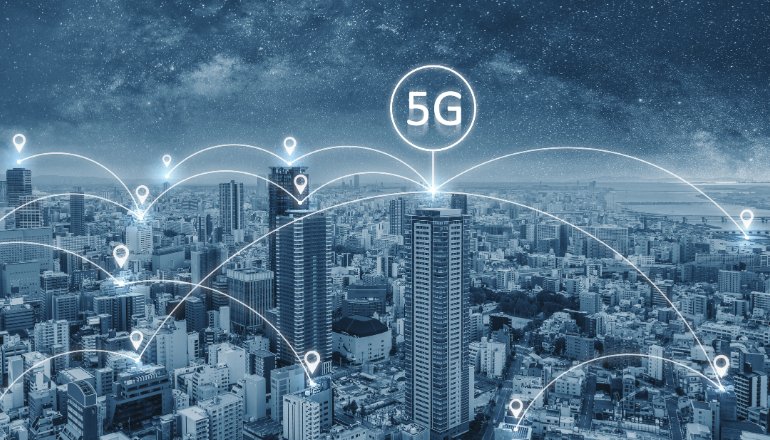While talking about cellular components, you may have heard the terms like SIM (nano-SIM, Micro SIM,, etc.,) eSIM, and iSIM. All these terms refer to a component that serves the same core function. You must be aware of SIM, SIM card sizes, and how it helps you to stay connected with the world. Recently, the tech world is all wrapped in the discussions related to eSIM.
With iPhone integrating eSIMs in their latest iPhone 14 series – and others planning to follow suit – it has become a household term. Large businesses worldwide are strategizing how eSIM technology can benefit connected devices and IoT solutions. According to a prediction done by Juniper Research, the embedded SIM market will soar to $16.3 billion by 2027.
Interestingly, another advanced form of SIM, i.e., iSIM, is making rounds and ready to hit the tech market with a bang. Qualcomm revealed the iSIM at MWC 2023. Are you curious to know what is this advancement in SIM technology? How is iSIM different from an eSIM and an ordinary SIM card? Whether it’ll be a game-changer in the future? Stay put, we’ll tell you all about iSIM technology in this blog.
An iSIM or Integrated SIM, also known as the Integrated Universal Integrated Circuit Card (iUICC), is the next step in the evolution of the SIM card. It is the most advanced, efficient, and flexible device-side network equipment.
Table of Contents
What is iSIM?
iSIM stands for Integrated SIM and is an advanced form of eSIM. eSIMs are small chips attached to the phone’s motherboard. On the contrary, iSIM is embedded into the processor for cellular connectivity and subscriber identity management facility. It is the most advanced, efficient and secure device-side network equipment.
Integrating SIM into a System-on-Chip (SoC) lowers the required footprint on the device for connectivity components. These advanced SIMs are heavily focused on digital security and will make devices extremely hard to tamper with. On the other hand, old-school physical SIMs need to be pushed in or embedded into a device.
Is iSIM Better than eSIM?

With iSIMs still a concept with an expected deployment commencing in 2025 and eSIMs just starting their journey, it is tough to tell which is better. We can’t even compare each other at this point of time. One thing is for sure: both will coexist for a long time.
The embedded SIM comes integrated into a device, and there’s no need to replace the SIM when you plan to switch to another network. With eSIMs, you can do most things with a QR code without opening your mobile, pulling out SIM, or replacing it. This means that we don’t need to manufacture a whole lot of SIM cards. Moreover, eSIMs bring in more efficiency and flexibility for consumers as well as businesses.
Now, moving on to iSIM. It also comes with many benefits; the foremost is security and not having to replace it. As it is incorporated into the device’s central processor, an iSIM is almost not a SIM card. Theoretically speaking, iSIM can replace eSIM. However, it seems a long way off.
As it is fully integrated into the device, many smartphone manufacturers are still clueless about it. Developing them in large quantities could be difficult and time-consuming. Compared to eSIMs or traditional SIM cards, iSIMs will be less off-the-shelf product. So, manufacturers may prefer the eSIMs just because of the ease of manufacturing and quick production. But we never know what may happen in the future.
Why Would a Phone Manufacturer Choose iSIM?
There are multiple reasons why manufacturers will choose iSIM over an eSIM. The foremost being the size. iSIMs are 98% smaller than eSIMs as they are a part of the device’s CPU. SIM card size has always bothered phone manufacturers, especially off late. They’ve always wanted more space inside, and iSIM does it efficiently.
Remember when phone manufacturers introduced mini-SIM, micro-SIM, and nano-SIM. The customers got excited and rushed to carriers for compatible SIM sizes. The iSIM, being more advanced, has taken the game to a whole new level by taking out the SIM card completely.
When it comes to SIMs, size does matter. It affects what we can connect. With iSIM, we can easily connect smaller devices, which is very beneficial for the Internet of Things (IoT) and Machine-to-Machine (M2M). Additionally, as iSIMs aren’t separate components, they require much less power to operate. An iSIM requires 70% less energy than an eSIM or a physical card.
Their development is much more complex and requires more time and technology. However, when they reach the manufacturing stage, the simple design and the use of fewer components mean they cost half as much to build.
Benefits of iSIM
The most advanced version of the SIM, an iSIM, offers various benefits over other forms of SIM.
Small size
Transferring cellular modem and SIM into a System on Chip (SoC) cuts the footprint on the device for connectivity components. This allows for better space optimisation of space created inside. For instance, special labels can have a tool to follow items while they’re being sent. Small tools can be put into things like smart glasses for virtual or extended reality to make them connect better and do more things.
Reducing the size of SIM and other components will significantly boost consumer devices/wearables like smartwatches, standalone augmented reality (AR), and virtual reality (VR) headsets. All these gadgets promise to augment smartphones in the coming times or may even replace them.
Security
As the iSIM is ingrained in a secure location into a SoC, you can be rest assured about its security. Also, the security can be customised based on the device’s requirements or according to the liking of the manufacturer.
The Trust Connectivity Alliance – which aims to promote global standardisation of Integrated SIM – recognises the specifications for the Tamper-resistant element (TRE), which is vital for maintaining consistency for iSIM security. A TRE is an independent hardware component of the SoC. It runs low-level software to enhance the safety of iSIM by defending it against attacks – physical or virtual.
The earliest chipset from Qualcomm that supported an iSIM was Snapdragon 888 and it came in 2020. The chipset comes integrated with a Secure Processing Unit (SPU) with a Secure Element (iSE) to secure the data stored on an iSIM.
Low power requirements
The iSIM doesn’t need an independent microprocessor and draws power from the SoC to function. Its functioning is limited, so it requires much less power and doesn’t affect the SoC’s working. Having a powerful SoC means more power to the iSIM in less time, ultimately enhancing cellular response.
The latter will be a significant factor for the next generation of mobile & IoT devices as speeds will increase to gigabytes, plus the increase of our dependency on data connectivity. With LPWA (lower power wide area) technologies such as LTE-M (LTE machine-type communications) and NB-IoT (narrowband IoT) combined with 5G and other advanced protocols, companies can promise excellent performance and streamline their operations.
For instance, in game streaming services, all processes are done on a cloud-based server. So, following the same sequence, the processing capabilities of smaller devices like smartphones may be done onto the cloud. The hardware will only be used to display the required information. With its low power consumption, an iSIM promises huge potential and will prove to be extremely useful in such scenarios.
Compatibility with 2G, 3G, 4G and 5G

The entire telecom industry recognises iSIM technology, and going forward it will be available with rigorous security features when used commonly by carriers. The GSM Association and other organisations have standardised the iSIM specifications.
These organisations include leading bodies like the Trust Connectivity Alliance, European Telecommunications Standards Institute (ETSI), 3GPP, and Eurosmart. The iSIM complies with the specifications of the European Telecommunications Standards Institute (ETSI) and GSMA’s specifications of machine-to-machine M2M.
Moreover, it can support all generations of mobile network connectivity and link to any carrier service. iSIM can be used with various cellular calling and data plans. For instance, if you travel between countries, you can switch from one network to another without needing a new SIM.
Applications in IoT
As the iSIM is small and compatible with various industry communication standards, it helps to popularise standalone and battery-powered IoT devices. Currently, we perceive IoT capable of handling only big devices with large sensors.
However, the groundbreaking iSIM technology promises to enable smaller form factors like gas & electricity metres, medical equipment, and vehicle telematics which involves monitoring a bulk of car information, especially autonomous vehicles. Apart from automobiles, telematics can be used for drones, too.
One great example of iSIM’s capability in IoT can be seen in Vodafone’s video. They’ve shown the potential benefit of smart labels, backed by an iSIM, placed on parcels to monitor the state in which they are shipped from pick up till its destination. This is one advantage of iSIM, where experts believe it can replace conventional ways like RFID tags.
Potential Applications for iSIM Devices
iSIM is the further continuation of eSIM technology. The foundations are the same, and iSIM also aims to provide flexible, secure, and seamless connectivity by being reliable. It promises much more owing to its small size, reduced power consumption, remarkable performance, and various possibilities to enhance applications and taking connectivity to a whole new level.
Some of the crucial applications of iSIM are as follows:
Asset tracking and monitoring
Leading organisations like to monitor their goods for reasons like:
- To ensure the safety and security of their goods and monitor high-value products through the supply chain.
- Optimise logistics, keep track, and report where exactly the products are and inform customers of all details like time required for delivery.
- Check the journey of goods like fresh food and human tissue to ensure they are kept in the right environment with warnings in case the environment is changed.
Wearables
With the prevailing miniaturisation, we’ll see connectivity added or booted to wearables like smart glasses, smartwatches, and health monitoring equipment. Being a cellular device itself, you won’t need to tether the wearable to a smartphone. It also ensures the security required for authentication and handling of sensitive data.
Smart utilities
Utility companies worldwide must closely monitor and manage metres and numerous sensors throughout their supply networks. These devices, like metres and controllers, are strategically placed at a distance and often in inaccessible locations requiring power to operate for a long time.
Any environmental effects, attacks, or unseen events can happen at any time. Their expensive network and sensitive equipment are vulnerable to outside factors. So, they can leverage the connectivity of iSIMs to safeguard their equipment and ensure uninterrupted services throughout.
Smart tracking for fleets
Many cities in Europe and other countries have fleets of e-bikes, scooters, etc., for hire. They also require rigorous tracking of their movables. So, they can use small tamper-proof devices that are secure & backed by batteries to keep track of their fleets. Ideally, these devices need small power to run for a long time and maintain connectivity while the customers roam around.
Automotive
Another practical use of iSIM for IoT is the Automotive sector, where connected cars have become a necessity. These cars require features such as telematics going from the engine to the infotainment system used for entertainment, communication, and navigation. Connectivity is also essential for offering emergency calls for assistance or warnings during unwanted incidents.
Which Network in the UK Will Provide iSIM?
With eSIM capturing the market and more and more smartphone manufacturers turning their attention towards it, we can expect the iSIM to be launched in 2025. While in the UK, we expect leading Network providers like Talk Home, Vodafone, and Now Mobile to take the lead in launching iSIM for public use.
Moreover, experts suggest that iSIM poses no threat to eSIMs and can coexist for several years. iSIM being more innovative and beneficial – especially in IoT – will prove groundbreaking in the coming times. Known as a disruptive technology, telecom giants like Qualcomm Technologies, Vodafone and Thales have already combined to showcase the world’s first smartphone demonstration of iSIM in January 2022.
Conclusion
iSIM is the next big thing in the telecom industry and is undoubtedly a breakthrough in the evolution of SIMs. Expected to be launched in 2025, we’re seeing major industry stakeholders developing the technology to improve device efficiency and performance.
In 2025, we can expect a whopping 200 million iSIM-compliant devices in use. The initial use cases could be the leveraging of efficient power capabilities of iSIMs combined with LPWA networks, compatibility with different generations of mobile networks, and efficient application in IoT. It is likely to be adopted in wearables for its size, tracking of fleets, the automotive sector, and many other industries.

